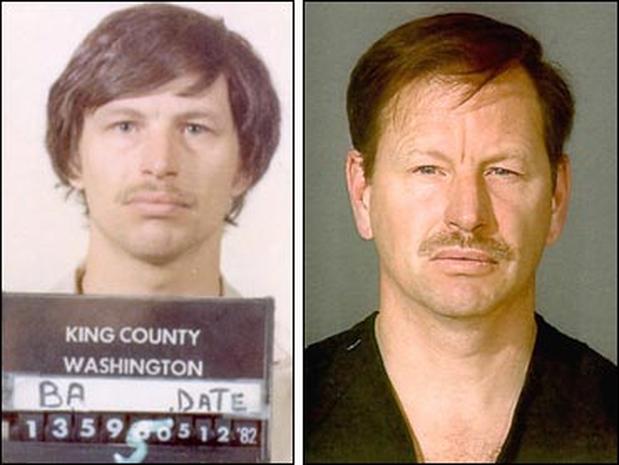The women in King County, Washington, lived in fear of the Green River Killer from 1982, when the first victim’s body was found face down in the Green River, to 2001 when he was finally caught. Nobody would have guessed that the person responsible for over seventy murders was their town’s local trunk painter, Gary Ridgway. From 1982 to 2001, the number of dead runaways and prostitutes piled up around the Seattle area. It took police two decades to finally put this man behind bars and it was all thanks to a new style of DNA testing.

All of Ridgway’s victims had a similar profile: they were all either prostitutes or runaways. Ridgway later stated that “[he] picked prostitutes as [his] victims because [he] hated them and did not want to pay them for sex.” His main method of killing was strangling the victims in either his home or his truck. He would then throw the bodies in grass areas or into the Green River. He would often return to the dumpsite to have sexual intercourse with the corpses. Little did Ridgway know, his necrophilia was what would get him caught.1
A key victim in this case was Marie Malvar, a seventeen-year-old who had begun selling herself to men, likely because her boyfriend was a pimp. While she and her boyfriend were out one night, she left and got in a pickup truck. Her boyfriend began to follow it to make sure she was okay; unfortunately for Malvar and her boyfriend, the driver got away because of a stoplight. Little did her boyfriend know that that was the last time he would see Malvar. He and her family began intensively searching for her. Fortunately enough, her boyfriend got a good look at the truck, and he recognized it when they were out searching for Malvar and anything that could bring her back home safe. The truck he recognized was parked outside of the house that belonged to Ridgway. When police were informed about him, they questioned Ridgway, but they could not legally arrest him because they found no further evidence with which to charge him. Malvar later became known as the first victim linked to Ridgway. It took decades to discover Malvar’s body in 2003.2

Another key victim in this murder investigation was a woman named Kim Nelson, a twenty-three-year-old who disappeared while in Seattle in 1983. While Nelson was out at night, a woman spotted her getting into a man’s truck. She was lucky enough to get a look at the man who was driving the car. With this information, the witness went to the police and began describing the man to a sketch artist. Soon after this, the police realized that the sketch looked a lot like Ridgway, who was still at the top of the list of suspects because of Malvar. They then showed the witness photos of men that fit the profile she described, and she pointed to Ridgway immediately.3
This created probable cause and allowed police to bring in Ridgeway and take bodily fluid samples from him as DNA evidence. It also gave police a warrant to search his truck and house, none of which had any type of evidence to connect him to any of the victims. This ultimately led to a killer being let back on the streets of King County.3
Piles of bodies began to be found all over the Seattle area, not just in the Green River, but also scattered around the woods. As the investigation went on, the police became aware that the Green River Killer tended to have sex with his victims postmortem. Because of this, the police were able to collect semen samples from multiple victims.5
Unfortunately, the forensic technology they had at that time was not advanced enough to connect the collected evidence to a person. This eventually led to Dave Reichert bringing in Beverly Himick, a DNA analyst, to work on the case. By the time Himick was on the case in 2001, there were very little semen samples left because of all the failed attempts to match the DNA with the killer. The only thing she had to work with were cotton swabs with very little DNA on them; little did they know, the cotton swabs would be the key to breaking the case. Himick used a new technique called Short Tandem Repeat (STR), which allowed her to create a genetic profile of the Green River Killer. This connected him to four victims. After this, Himick put the information into the national DNA database, which then led them straight to Ridgway.6
Another piece of evidence that was used in trial against Ridgway was the paint on three of the victims’ clothes. The paint particles were so small that they could only be seen using a high-powered microscope. This was discovered by a forensic scientist named Skip Palenkik. Although this may not seem like much, the type of paint that was found on the clothes was unique. This type of paint was not sold in stores because it was made specifically for car painting. The paint matched the kind that was used at Ridgway’s job. This made it extremely difficult for the jurors to think that Ridgway was somehow not the Green River Killer.7

After the Green River case remained open for twenty years, Ridgway was finally arrested at his worksite in November of 2001 for the murder of four women, and he went willingly to the station. At first, he pleaded not guilty; however, with all the evidence that was piled up against him, Ridgway decided to plead guilty to forty-eight murders that he committed in the span of two decades. To avoid the death penalty, Ridgway made a deal with the police, telling them that he would take them to find all of the bodies that he had left over the years.8
Ridgway admitted to dumping the women in threes “because [he] wanted to keep track of them all.” This was ultimately why Ridgway was able to take police to all of the sites and the only reason that he did not face the death penalty while on trial.9 Although Detective Reichert knew that this might anger some of the victims’ families, he stated that “the majority of the families were understanding and in agreement that it was probably the best decision given the circumstances.”10

Finally, in December of 2003, the jury convicted Ridgway on forty-eight consecutive murder charges without the possibility of parole. He was put in the Washington State Penitentiary in 2002. While Ridgway was behind bars, more and more bodies were discovered that were linked to him. In February 2011, another body was discovered that was connected to Ridgway, to which he again pleaded guilty, giving him another life sentence. In 2013, Ridgway claimed to have killed over eighty women, but that has not yet been proven. In 2015, he was transferred to USP Florence, a high-security federal prison in Colorado, which is where he remains to this day.11
Gary Ridgway is the second most prolific serial killer in the United States. There have been multiple movies made about the Green River Killer and numerous books about his unbelievable story. Although it took twenty years, justice was finally served for the eighty plus women who were murdered at the hands of Ridgway. That would not have been possible if it were not for the advances that were made in forensic technology, which is what brought the key factors to the forefront to solve this once cold case. After 2001, when Ridgway was arrested, women were able to walk the streets again without having to fear the infamous Green River Killer.
- “In Plea Deal, Green River Killer Admits He Murdered 48 Women,” Los Angeles Times, November 6, 2003. https://www.latimes.com/archives/la-xpm-2003-nov-06-na-green6-story.html. ↵
- Anne Rule, Green River, Running Red The Real Story of the Green River Killer—America’s Deadliest Serial Murderer (New York, NY: Free Press, 2004), 107-109. ↵
- “Gary Ridgway: “The Green River Killer” – Serial Killer Documentary,” video file, 5:02, YouTube, posted by Serial Killers Documentary, July 9, 2017, https://www.youtube.com/watch?v=PuokSat3y6o ↵
- “Gary Ridgway: “The Green River Killer” – Serial Killer Documentary,” video file, 5:02, YouTube, posted by Serial Killers Documentary, July 9, 2017, https://www.youtube.com/watch?v=PuokSat3y6o ↵
- “Gary Ridgway: “The Green River Killer” – Serial Killer Documentary,” video file, 5:02, YouTube, posted by Serial Killers Documentary, July 9, 2017, https://www.youtube.com/watch?v=PuokSat3y6o ↵
- “Gary Ridgway: “The Green River Killer” – Serial Killer Documentary,” video file, 5:02, YouTube, posted by Serial Killers Documentary, July 9, 2017, https://www.youtube.com/watch?v=PuokSat3y6o ↵
- Brooke Kaelin, “How Forensics Finally Caught Up With The Green River Killer,” Forensic Science Degree (website), November 11, 2015. https://www.forensicsciencedegree.org/how-forensics-finally-caught-up-with-the-green-river-killer/. ↵
- Wilmot Matthew, “ Sparing Gary Ridgway: The Demise of the Death Penalty in Washington State 41, no., 2 (2005): 435-456. ↵
- “In Plea Deal, Green River Killer Admits He Murdered 48 Women,” Los Angeles Times, November 6, 2003. https://www.latimes.com/archives/la-xpm-2003-nov-06-na-green6-story.html. ↵
- “Green River Killer Avoids Death in Plea Deal,” CNN Cable News Network. Accessed October 30, 2019. http://www.cnn.com/2003/LAW/11/05/green.river.killings/. ↵
- Salem Press Biographical Encyclopedia, 2018, s.v. “Gary Ridgway,” by Kennedy Adrienne. ↵



85 comments
Alexandria Wicker
This article was so interesting. I have never heard about the Green River Killer, but personally I am very interested in reading about stories like this one. I think it is insane how this was over two decades and he actually confessed to over 80 murders. I think it is so crazy that someone can get away with murders like the way these murders were executed. This was a well written and really interesting article!
Nathan Castillo
I have never heard of the Green River Killer up until now, and this article was very interesting. Though the time span was two decades, the action of killing 80 women is absolutely absurd. Along with him dumping the bodies, but his necrophilia actions were the most disturbing part. It is very unfortunate that DNA testing was not that advanced as it is now because we could have caught him so much sooner than that. Other than that, this was a very interesting article!
Diego Oviedo
The story was very interesting, I had never heard about the Green River Killer. Reading the story in a way it gave the chills because of the murders he had gotten away with it over the years. It surprises me that he actually confessed to 80 and more of the murders he committed. In a way it goes to show how heartless this individual is, I can’t even begin to imagine the pain all the families went through until they finally got justice. It is amazing that they were able to catch him and bring justice to all the families after all this year.
Mia Hernandez
This story was unbelievable! I had never heard about the Green River Killer before this article but his story was very intriguing. I can’t believe he confessed to over 80 murders and had gotten away with it for many years. That is so scary. I can’t even imagine the pain the families felt waiting so long for justice to be served. I’m so grateful that forensic science has advanced. It was very well written and loved the article.
Alicia Martinez
This article was very interesting and informative. I had not known of the chilling story of the Green Wood Killer. It is also unbelievable that he had confessed to killing over 80 women. Even more so, the bodies were scattered across the woods and it took decades for them to be found. It is amazing how forensic technology has developed to solve cases such as this one and connect victims to their murderers with little evidence.
Alison Morales-Aguilar
What a horrific story! I mean just from the get-go when he said he killed prostitutes because he didn’t want to pay them? That is such a stupid and inhumane reason to kill someone. I felt so gross when he mentioned that he dumped the bodies in groups of three so he could keep track of them. I feel so bad for the families who had to wait every year hoping their daughter or wife and sister was one of those lucky 3 that year.
Justine Ruiz
This was my first time reading about the Green River Killer. This article honestly gave me chills because he managed to kill more than 80 women and get away with it for so long. I’m glad that the forensic science needed to catch him has advanced since then because it took officers ten years to fully make an arrest.
Victoria Hoggard
This was my first time hearing about the Green River Killer and it is so creepy and chilling to know he killed seventy people and it took them two decades to find him. It’s also so scary that even after he was sentenced they discovered that there were more murders connected to him.
Aracely Beltran
The fact that he killed seventy people is crazy to me. And not to mention that it took them two decades to find him! I feel so weird knowing this. How many people suffered and his necrophilia is the cherry on top of this horror story. Great article, very well written! Kept me interested the whole way through, it was one of those times like when you want to look away but you can’t because you want to know how it ends.
Aaron Sandoval
This article was really fun and interesting to read, I for one have always been interested in serial killers, and why they commit the atrocities that they do. I have only ever briefly looked into Gary Ridgeway while taking the class Great American Murder Trials, and this article did a good job of covering what I knew, I discovered there was a lot I did not know about this murderer.